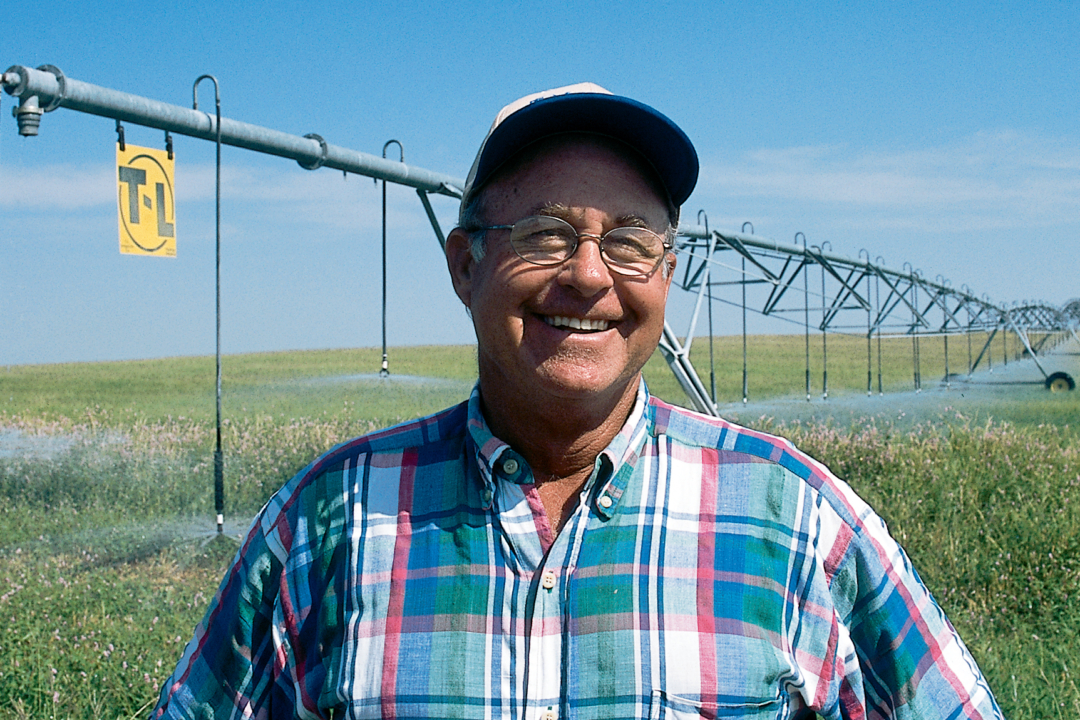Read stories from farmers all around the world and why they chose T-L.
Warren Fox
"If I could take a vacation with all the money I've spent on T-L parts and labor over the years it would be pretty short."
Typical of many farmers in his region, the ground that Warren Fox, Plains, Kansas, farms is sandy, loamy soil on rolling hills. So, when he began irrigating he didn’t even consider flood irrigation. As he notes, “Even if flood irrigation would have worked, which it couldn’t due to the expense of leveling alone, it just wasn’t efficient enough and I didn’t have the necessary labor.”
Warren Fox grows corn, soybeans and wheat. Fox also uses T-L pivots to irrigate grasses for hay to be fed to his cowherd. This eight-year-old field of WW Spar and Ironmaster is still yielding well despite its age. Fox takes off two cuttings after grazing it until June each year with his cows and spring calves by side. He irrigates two such grass circles from one well, with the pivots making a round every two days.
Now he has 30 center pivot systems on the move during the growing season. Fox had experience with irrigation systems from half a dozen manufacturers over the years. Twelve of his present pivots are T-L Irrigation Co. units, with more to follow, he predicts.
He bought his first T-L in 1988. He’d talked with his neighbors using T-L systems who told him they were getting along pretty well with them.
“I was looking for simplicity,” Fox points out, “In short, a pivot that would keep on making circles without a lot of repairs and expense. I also liked T-L’s continuous movement, no start-stop like an electric system that can make an uneven water pattern. What I’ve found is that T-L is a stout machine with a structure that can’t be beat.”
Fox likens the continual starting and stopping of electric systems to using an impact wrench on the unit’s parts since it starts at 100% speed and shuts off the same way. Electrics are just not the low maintenance machines that T-L’s are, he believes, based on experience.
“If I could take a vacation with all the money I’ve spent on T-L parts and labor over the years it would be pretty short”, Fox smiles. During the thirteen years he’s been using his first T-L system the only repairs it has needed have been one gearbox and a couple of 3/8 inch bolts in the driveline.
According to Fox, “That system is as dependable as the first day I bought it. Look at the storage bins in my shop and you’ll see only a handful of T-L parts, and I have had bins full of electrical pivot parts.” He adds, “I almost always check my T-L systems last every morning, because I know they will be running and won’t require maintenance. I don’t find that with my electric machines.”
It’s difficult to calculate the true cost of a repair shutdown, Fox says, but he thinks that crop losses due to three or four shutdowns a season while the unit sits a half-day or more, can quickly add up to affect his bottom line.
On the other hand, Tom Wright IV of Lakin, Kansas, started with flood irrigation. His methods evolved from ditch, to pipe, to surge valves over the years, yet he still wasn’t satisfied. “I was looking for more efficiency and labor savings,” he recalls, explaining why nine quarter-mile and two half-mile systems have replaced flood irrigation on his land.
“The 60 to 80 acres we could typically handle under flood irrigation expanded to 180 acres under pivots and meanwhile increase our yields.” Wright continues, “Pivot irrigation is also a lot easier on the body. Since I quit flood irrigating I don’t have back problems.”
In contrast to Fox, all of Wright’s pivots are T-L units. He says, “I decided in the beginning to go with the hydraulic T-Ls and I haven’t regretted it. In eight years the total of downtime with our 11 units has been only five or six hours. I’ve liked the T-L strength and reliability,” he continues, “since they seem to be built good and hold together well. I also like being able to keep everything as safe as I can for my employees and me. I wouldn’t want either of us working on an electric system.”
Efficiency is also important to Wright since his wells range in capacity from barely 300 gallons a minute to 450 gallons a minute. He’s also noticed none of the “spoking” effect typical of the continual starting and stopping of a neighbor’s electric pivots. This can leave portions of a crop wilted immediately after the pivot has moved on.
The start stop factor no doubt contributes to increased wear, too, he reasons. As for his T-L dealer service, Wright says it’s gone from good to even better. And, he likes the full service offered that enables him to deal with just one firm for everything from irrigation well to pipe to sprinkler.
Summing up his experience with T-L pivot systems, Wright says, “You can buy cheaper systems, but you get what you pay for. I’m also a Pioneer seed salesman and here also you can buy cheaper seed elsewhere, but you can’t count on the best yields with it.”

- Products
- Center Pivot
- Crops
- Corn, Soybeans, Wheat
- States
- Kansas
- Countries
- United States


